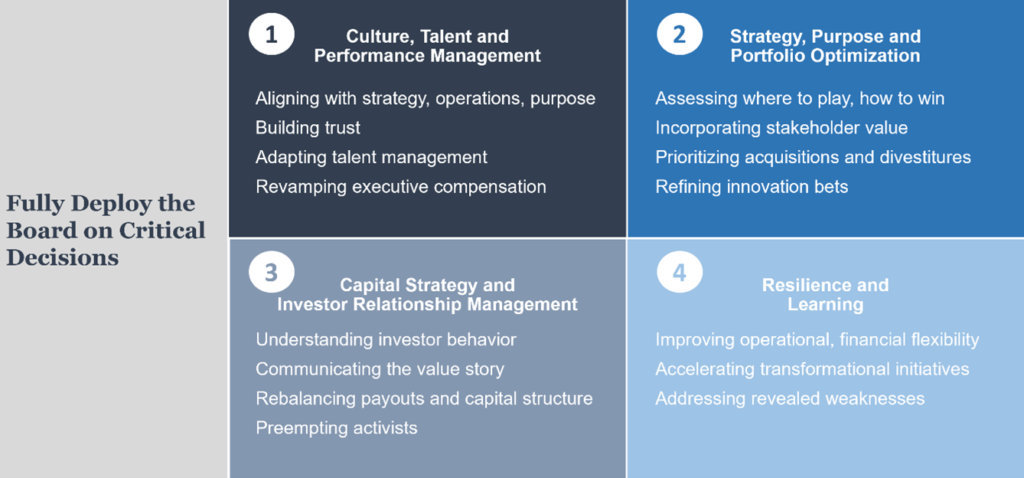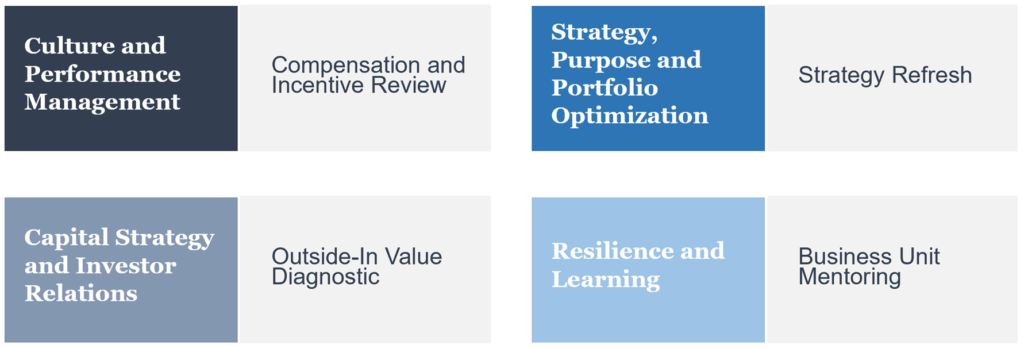Fuente: Harvard Law School Forum on Corporate Governance, Corporate Board Member
Autor: Jeffrey R. Greene, Fortuna Advisors LLC, and Sharath Sharma, EY
Management teams do not have to confront the pandemic’s daunting challenges alone. As they move from stabilizing cash flow and reengineering workplaces to creating a little breathing room—both financially and mentally—CEOs and directors should reflect on how to deploy their boards most effectively.
Regardless of where company performance lies on the spectrum—from distressed (physical retailers) to thriving (video conference software)—leaders can improve outcomes by:
- Systematically involving directors in critical decisions on strategy, culture, building resilience, investor communications and compensation
- Efficiently facilitating directors’ education about the company and its markets
- Fully utilizing the board’s collective experience, diverse perspectives, real-time insights and extended networks
Management and shareholders cannot afford to underutilize the board in addressing this crisis, for which there are no playbooks, or its aftermath, which is unlikely to resemble any past recoveries.
Companies face challenges across multiple dimensions—medical science, health care, financial markets, economics, supply chains and geopolitics—to which their only viable approach is an adaptive problem-solving process that is swift and decisive, yet iterative, as new information arises.
Heightened and rolling uncertainties in each domain mean executives must resolve continued tensions between coping in the short-term and preparing for eventual recovery phases. Director input helps balance these trade-offs.
Figure 1: Improve shareholder returns through active board engagement
A case study in facilitating informed advice and oversight
In deciding how to educate, inform and engage directors in the current environment, Netflix governance practices provide an instructive case study:
- Directors attend regular senior management meetings as observers.
- In advance of each board meeting, directors receive a narrative memo of 20–40 pages describing performance, industry trends and competitor developments, with links to underlying data and supporting analysis.
- Directors have access to all information on the company’s internal systems.
- Board members are empowered to follow up individually with the CEO and other executives.
These practices originated to build director belief in the credibility of management’s long-term plans. Since then, they credit management’s transparency and willingness to debate with enabling confident decisions:
There are so many radical major transformative steps that Netflix has done since I’ve been on the board: DVD distribution into streaming over the web, moving into international, committing millions of dollars in content … The management team is so thoughtful and open to dissension in the decision-making process that it makes very challenging decisions relatively easier because of the rigor of the process.
Each action could apply directly to the crisis management, recovery and future growth challenges every company must adapt to today. Well-informed directors with open communication channels to management can debate issues in real time and test assumptions that underpin executives’ recommendations.
Advising on critical decisions: a checklist
In an environment with no easy answers and an overstretched C-suite, effective board engagement can mean the difference between muddling through and thriving in the post-pandemic world. Consequential, urgent decisions benefit from quality board input as they’re being structured, not just when it’s time for formal approval:
Culture, talent and performance management
What steps can we take to make sure we have a coherent corporate culture that supports and informs our strategy, operating model and purpose?
Medtronic’s new CEO, Geoff Martha, recognizes the talent management challenges: “The younger generations, Gen Z in particular, will make future employment decisions in large part based on how companies are showing up in this pandemic. The social responsibility piece of this will have a direct impact on your ability to attract and retain top talent.”
How should we restructure executive compensation to better align with refreshed priorities to drive long-term value?
Commenting on Electronic Arts’ recent say-on-pay vote, the editor of Chief Executive said, “…employee compensation is in a state of flux unseen since the Great Recession.” [1]
Strategy, purpose and portfolio optimization
As the crisis cascades through industries, altering the attractiveness of our existing businesses and competitive advantages, how should our strategy adapt?
Looking beyond a pandemic-driven short-term earnings decline, IBM has committed $1 billion to investing in ecosystem partners to support the build-out of its hybrid cloud strategy.
What role should creating societal value play in our updated strategy?
Lenovo launched “a partner stimulus package to expedite payments to distributors and solution providers in its supply chain.”
What M&A opportunities arise based on our new priorities and intelligence on struggling competitors?
Recent acquisition announcements by NVIDIA and Chevron show how financially sound players can add complementary capabilities while shaping industry consolidation.
Should we divest any non-core businesses to stabilize the core or fund new opportunities? How should we refine our portfolio of innovation projects? What new business models should we be testing?
To help protect health care workers, Medtronic has ramped up its offering around remote device management, so, for example, ventilators can be monitored from outside the ICU.
Figure 2: Fully deploy the board on critical decisions
Capital strategy and investor relationship management
Do we have a deep understanding of what will drive investors’ behavior post-pandemic? How should we communicate our evolving value-creation story to them?
Which mix of financial policies is now appropriate—dividends, share repurchases and capital structure?
Should we put in place a poison pill to guard against a hostile acquiror taking advantage of a temporary gap between our stock’s price and its intrinsic value? How can we remedy potential vulnerabilities to preempt an activist shareholder’s critique?
Resilience and learning
How can we better prepare for the next black swan or gray rhino? How much efficiency should we trade off in favor of operational and financial flexibility?
Which transformational projects (such as digitalization or reorganization) can we now accelerate—leveraging the sense of urgency created by the crisis?
A new CEO “is using the COVID-19 crisis to transform Disney much faster than expected, all with an eye toward making the company an online juggernaut that reaches far more people worldwide.”
What weaknesses in policies and processes has the crisis revealed that we need to fix?
These questions demonstrate the broad scope of short- and long-term issues executive teams face today. Their responses to the existential threats and novel opportunities presented by the crisis will be incomplete without a well-engaged board.
Exploiting perspective, experience and relationships
At a time when management is increasingly dedicated to “putting out fires” with limited ability to plan or consider longer-term consequences, the board provides a unique and often underutilized pool of resources:
Broad and deep experience. Directors bring centuries of collective experience across industries, functional disciplines, government service and academia. Many can share lessons learned from living through—and often leading companies through—past economic turmoil like the global financial crisis and dot-com bubble bursting, as well as the SARS and Ebola outbreaks.
The board should complement management’s thinking around building robust scenarios that span what’s possible, then sequencing investment plans. And directors’ outside perspectives will enhance the debate on how to implement stakeholder-centricity, given the wide range of current practices.
Cognitive diversity. The ability to generate a wide range of alternative solutions is critically important in complex, highly uncertain situations like the current crisis. Beyond the gradual progress being made in achieving diversity from gender and sexual orientation, recent research demonstrates the value of “cognitive diversity” in problem-solving—leveraging differences in how people process information and use expertise when faced with new situations.
Conversely, if everyone on the team approaches problems the same way—low cognitive diversity—it’s difficult to think outside the box, and better answers may be missed.
Real-time insights. Drawing on their current roles as executives and board members at other organizations, directors can synthesize live case studies on how those leaders manage the crisis and plan for its aftermath—particularly when directors have exposure to industries and regions reopening at different rates.
Extended networks. George Day and Paul Schoemaker point out how directors help managers improve their “vigilance”—the ability to identify potential internal problems and disruptive external trends. In addition, directors’ mine their relationships to identify potential acquisitions, ecosystem partners, alternative suppliers and recruiting candidates from other industries.
Complementary incentives. Other characteristics of the director’s role guard against risk aversion and short-termism:
- Their tenure in S&P 500 companies averages more than twice that of CEOs (11 years 5 years), so they can encourage and oversee investments that pay off over several years. This is especially relevant because most companies’ valuations depend on cash flows beyond five years. [2]
- Director compensation is usually some combination of fixed fees and equity ownership, which helps align their incentives as shareholder representatives. Beyond financial remuneration, their primary motivations revolve around their reputation and how other directors perceive their contributions.
- Board decisions that prioritize the long-term interests of the company are protected from being second-guessed by a court if directors act with due care and in good faith. This “business judgement rule” is the centerpiece of Delaware corporation law.
Implementing optimal board engagement at your company
The archetypal governance practices we describe above work best in corporate and board cultures that encourage candid feedback, honest debate and the open sharing of information. How can your company migrate to a culture where executives won’t feel threatened or distracted when directors observe senior management meetings and have access to all the same data?
Figure 3: Use pilots to migrate toward leading practice board engagement
As with any change process, pilot projects can help build confidence, trust and rapport by gradually involving the board more deeply in key decisions and sharing more information. On the director side of the quid pro quo, they need to commit to participating in line with their oversight and advisory roles. Here are four possible pilots for CEOs and boards to consider:
- Strategy refresh. A leading practice for the board’s role in strategy has been to solicit board input at kickoff and during development, well before asking for formal approval. Adopting a more engaged approach would augment this process with one or two directors observing key working meetings of the strategy team. The team would also share their research and analyses along the way as they build scenarios, formulate strategic alternatives and converge on recommendations.
- Business unit mentoring. Experiment with implementing the new approach in a single business unit (BU) by assigning two directors as mentors who observe BU operating committee meetings, interact with executives and discuss their learnings with the rest of the board. Sharing information would begin narrowly with what’s relevant to meeting agendas, then expand as trust builds. Board members can play a devil’s advocate role in helping assess lessons learned and building resilience against future disruptions.
- Compensation and incentive review. Work with the compensation committee to construct and evaluate alternatives to your current incentive plan that may align better with long-term value creation, especially in a post-crisis world. In the short-term, directors’ external insights could also assist in stabilizing morale and raising confidence as employment- and health-related anxieties subside.
- Outside-in value diagnostic. Apply an investor’s “lens” to examine the company’s performance relative to peers during the crisis, to develop potential improvement initiatives during the recovery. This data-intensive exercise resembles what an activist shareholder would do based on public information and allows the board to anticipate potential criticism and catalyze a focus on value creation.
While it takes a confident CEO and committed directors to engage the board using the governance practices we’ve outlined, the current environment presents the urgency and necessity to try. In confronting unique challenges on a daily basis, management teams can lessen the burden—and improve their results—by unlocking the board’s full potential in today’s fluid and unpredictable business landscape.
Endnotes
The views reflected in this post are the views of the authors and do not necessarily reflect the views of Fortuna Advisors LLC or Ernst & Young LLP and other members of their global organizations. The original articles in Corporate Board Member are available here and here.
1“CEO Briefing,” Dan Bigman, Chief Executive, August 17, 2020.(go back)
2We can see this with a simple example: Assume one year from today a business generates $100 of free cash flow that grows by 2 percent every year thereafter. Using a 9 percent cost of capital and the dividend discount model, the value of the business today is $1,429. The present value of the cash flows after year five years is more than 70% of the total.












